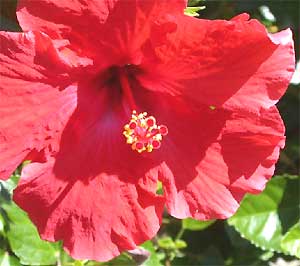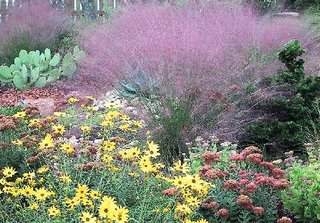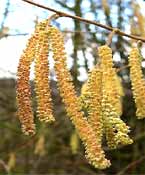Thursday, March 30, 2006
Hibiscus everywhere

I am a hibiscus lover and I'm not afraid to admit it. I have several varieties in my yard and am transfixed by the beauty of the blooms and their depth of color. So imagine how pleased I was to learn of Jason's web site Strictly Hibiscus.
This site offers every color you can think of and then some. My favorites are generally in the yellow or red categories. I particularly like Sun Kissed - a mix of bright yellow edging with white and a magenta center, and Intense Passion - a double bloom with red, coral and yellow.
There's even a Hibiscus of the Month Club to check out. Go out and visit when you get the chance. It's worth it. Happy Gardening.
Saturday, March 25, 2006
Xeriscape
When folks hear the word Xeriscape many times they picture a hot, dry area lacking lush plants and grass. The truth is Xeriscape provides the best way to grow plants while conserving water. Xeriscape is derived from the Greek word xeri for dry (needing little water) and embodies the principles of water conservation through creative landscaping.
 To employ the fundamentals of Xeriscape, the first step is proper plan and design keeping water conservation top of mind. Both native and non-native plants will perform well in a properly planned Xeriscape landscape. While true drought-tolerant plants will thrive, all plants can grow when placed in the proper environment. The secret is grouping plants with similar water needs together o create different water use zones.
To employ the fundamentals of Xeriscape, the first step is proper plan and design keeping water conservation top of mind. Both native and non-native plants will perform well in a properly planned Xeriscape landscape. While true drought-tolerant plants will thrive, all plants can grow when placed in the proper environment. The secret is grouping plants with similar water needs together o create different water use zones.
The use of soil amendments such as compost or manure provides nutrients, promotes stronger growth, and allows better water absorption. The addition of mulch reduces evaporation, keeps the soil cool, and reduces weed competition for water, space and nutrients. Mulching also helps capture rainwater by allowing hard rains to soak into the soil instead of running off into the street and drainage areas.
Grassy areas or turf can be included in a Xeriscape as long as it is properly managed. Limit the size of lawn areas and use the correct species of turf for the climate. Using native grasses or ground covers allow for controlled water usage and contribute to the beauty of the gardens.
Water conservation is a critical consideration in today's gardening. Planning and maintaining a Xeriscape garden is an ideal way to enjoy a beautiful landscape in a resource and water efficient way. Your local Cooperative Extension Service is a great resource for more information about Xeriscape. Happy Gardening.
 To employ the fundamentals of Xeriscape, the first step is proper plan and design keeping water conservation top of mind. Both native and non-native plants will perform well in a properly planned Xeriscape landscape. While true drought-tolerant plants will thrive, all plants can grow when placed in the proper environment. The secret is grouping plants with similar water needs together o create different water use zones.
To employ the fundamentals of Xeriscape, the first step is proper plan and design keeping water conservation top of mind. Both native and non-native plants will perform well in a properly planned Xeriscape landscape. While true drought-tolerant plants will thrive, all plants can grow when placed in the proper environment. The secret is grouping plants with similar water needs together o create different water use zones. The use of soil amendments such as compost or manure provides nutrients, promotes stronger growth, and allows better water absorption. The addition of mulch reduces evaporation, keeps the soil cool, and reduces weed competition for water, space and nutrients. Mulching also helps capture rainwater by allowing hard rains to soak into the soil instead of running off into the street and drainage areas.
Grassy areas or turf can be included in a Xeriscape as long as it is properly managed. Limit the size of lawn areas and use the correct species of turf for the climate. Using native grasses or ground covers allow for controlled water usage and contribute to the beauty of the gardens.
Water conservation is a critical consideration in today's gardening. Planning and maintaining a Xeriscape garden is an ideal way to enjoy a beautiful landscape in a resource and water efficient way. Your local Cooperative Extension Service is a great resource for more information about Xeriscape. Happy Gardening.
Friday, March 10, 2006
Catkins
No, it's not a cute name for a little furry animal. It's the stuff that drives folks crazy at this time of year. Catkins are the flowers from our oak trees. They are the little things that cover your car, patios, sidewalks and, more importantly, stuff up your nose and make your eyes water.
Produced by not just oaks but many other trees as well (hazel, poplar and birch to name a few), the name is derived from the Dutch katteken, or kitten, and refers to its resemblance to a cat's tail. It's ironic when you think of it because there are also many, many folks who are allergic to cats so why not to catkins?
The male catkins are the ones who drive everyone crazy. They are long just like a cat's tail and have more than a hundred little flowers. The flowers are unisexual and their purpose is to pollinate by the wind.
Interesting information, you say, but what about my watering eyes and itchy nose? Of course you can take the usual allergy medications knowing it will all blow over (no pun intended) within a few weeks. Or you can get even! Storm was out walking and, upon coming across Alder catkins, actually decided to eat them. He tried them raw, then boiled, and liked them so much he is ready to experiment with others. So, next time you see those catkins blowing through the air try catching a few for a snack. Let me know how it goes. Happy Gardening.

Produced by not just oaks but many other trees as well (hazel, poplar and birch to name a few), the name is derived from the Dutch katteken, or kitten, and refers to its resemblance to a cat's tail. It's ironic when you think of it because there are also many, many folks who are allergic to cats so why not to catkins?
The male catkins are the ones who drive everyone crazy. They are long just like a cat's tail and have more than a hundred little flowers. The flowers are unisexual and their purpose is to pollinate by the wind.
Interesting information, you say, but what about my watering eyes and itchy nose? Of course you can take the usual allergy medications knowing it will all blow over (no pun intended) within a few weeks. Or you can get even! Storm was out walking and, upon coming across Alder catkins, actually decided to eat them. He tried them raw, then boiled, and liked them so much he is ready to experiment with others. So, next time you see those catkins blowing through the air try catching a few for a snack. Let me know how it goes. Happy Gardening.
Wednesday, March 08, 2006
Remembering Beau

We lost one of our best friends last week. Beau was a staple around our house. We rescued him from a kill shelter when he was a pup of 1 1/2 years old. Always timid and quiet, he kind of got the short end of the stick sometimes when it came to pets and play. But when the thunderstorms started, he got ALL the attention and stayed plastered to my lap until all danger was gone.
When Beau reached 16 it was clear he was having lots of difficulties from hearing to sight to severe arthritis in his legs. He finally let us know that he wanted to be a pup again and go play in the grass. So we let him go. It was a difficult and heartwrenching decision to make but one we knew we had to allow.
Beau is now with our other pets lying in the sun and playing together, although the cats would probably not deem it as play. We miss him as we miss all of the others but he will always be in our hearts. Have a good romp Beau.

This work is licensed under a Creative Commons License.
Thanks to Andrew Stenning who contributed the photograph for our masthead


